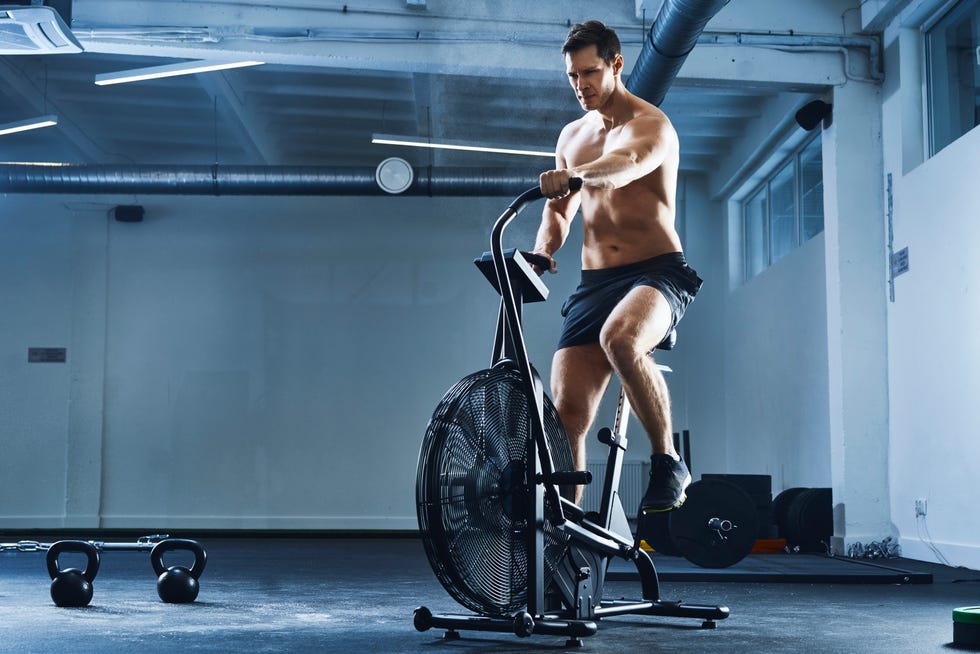Featured Posts
.
Wednesday, 18 September 2019
Monday, 10 June 2019
Thursday, 14 March 2019
How to Add HIIT to Your Workouts — the Right Way
Tabata Circuits
Full article : link
Ditch the
treadmill and use your own body. Each exercise is done for 20 seconds
with 10-second rest in between. This style of training was shown to be equally effective as traditional HIIT sprint workouts.
You'll perform a maximum of 8 sets of 20 seconds on, 10 seconds off.
It’s not for the faint of heart, but if you have a cardio machine
phobia, it does the job. Some movements for your Tabata training:
- High-knee running
- Squat jumps
- Mountain climbers
- Burpees
There’s
no need to duplicate the exact exercises used here, either. Full-body
exercises of any kind should substitute just fine. You can also
incorporate weights for an additional challenge.
Thursday, 31 January 2019
Get Sweaty and Torch Calories Anytime, Anywhere With These 8 Tabata Apps
Tabata burns calories and forces you to really work. It's a form of high-intensity interval training — short bursts of activity performed at close to your max capacity followed by even shorter rest periods — proven to shed fat and benefit cardiovascular health.
Tabata specifically follows intervals of 20 seconds on, working as hard as you can, followed by 10 seconds off for four minutes. Each four-minute round of, let's say, burpees consists of eight sets. Sounds fun, right?
Full article : link
Tabata specifically follows intervals of 20 seconds on, working as hard as you can, followed by 10 seconds off for four minutes. Each four-minute round of, let's say, burpees consists of eight sets. Sounds fun, right?
Full article : link
Friday, 18 May 2018
This Bodyweight Tabata Workout from Shaun T Is the Ultimate HIIT Routine
Extract:
New science behind HIIT keeps proving it’s one amazingly effective drill. Here’s exactly how to tap its potent benefits to transform your fitness
Full article : link
How much HIIT does it take to level up and also change your body composition? (And should you be doing Tabata training every day?) According to a new review of 65 HIIT studies in the British Journal of Sports Medicine, three times a week does it if you keep at it 12-plus weeks. Start your HIIT habit here. Try the Tabata session below from Insanity creator Shaun T. Here's how: Perform each move for 20 seconds (take note of whether you need to repeat on the opposite side), and rest for 10 seconds between each exercise. Repeat exercises as prescribed for a complete 4-minute Tabata workout.
New science behind HIIT keeps proving it’s one amazingly effective drill. Here’s exactly how to tap its potent benefits to transform your fitness
Full article : link
How much HIIT does it take to level up and also change your body composition? (And should you be doing Tabata training every day?) According to a new review of 65 HIIT studies in the British Journal of Sports Medicine, three times a week does it if you keep at it 12-plus weeks. Start your HIIT habit here. Try the Tabata session below from Insanity creator Shaun T. Here's how: Perform each move for 20 seconds (take note of whether you need to repeat on the opposite side), and rest for 10 seconds between each exercise. Repeat exercises as prescribed for a complete 4-minute Tabata workout.
Thursday, 26 April 2018
The 20-minute HIIT circuit that will get you fighting fit
In this article, author explains "High-Intensity Interval Training will get you both shredded in less time than your morning commute".
Extract:
HIIT — high-intensity interval training — is a combination of
high-octane bursts of intense exercise followed by low-intensity short
rest. According to the Academy of Sports Medicine, the benefits of HIIT
range from lowering cholesterol and improving blood pressure to lowering
body fat and maintaining muscle mass. A 20-minute workout such as
Musico’s can burn as many as 250 calories, and with HIIT’s ability to raise metabolism levels, you’ll burn fat long after you’ve taken off the gloves and gone back to checking your work emails.
Sunday, 11 February 2018
New to Tabata? This Workout Is For You
In this article, mostly oriented for beginners, you will discover the ABC of Tabata.
Exercises might not be intense enough to reach the 170% of VO2Max but it's a first step!
Extract:
The fitness world is full of jargon, but one word you need in your gym vocabulary is Tabata. The first thing to know is that it's a type of HIIT workout, aka high-intensive interval training. These workouts are designed to push you a bit out of your comfort zone, but they're great for revving up your metabolism. A four-minute Tabata round alternates between 20-second work intervals, followed by 10 seconds of rest. You repeat this on-off pattern a total of eight times. You can stack Tabata rounds to create longer workouts, resting one to two minutes between rounds.
Link
Exercises might not be intense enough to reach the 170% of VO2Max but it's a first step!
Extract:
The fitness world is full of jargon, but one word you need in your gym vocabulary is Tabata. The first thing to know is that it's a type of HIIT workout, aka high-intensive interval training. These workouts are designed to push you a bit out of your comfort zone, but they're great for revving up your metabolism. A four-minute Tabata round alternates between 20-second work intervals, followed by 10 seconds of rest. You repeat this on-off pattern a total of eight times. You can stack Tabata rounds to create longer workouts, resting one to two minutes between rounds.
Link
Wednesday, 7 February 2018
Celebrity Trainer Vinod Channa Recommends The Tabata Workout For People Short Of Time
In this article:
Tabata training was discovered by Japanese scientist Dr. Izumi Tabata
and a team of researchers from the National Institute of Fitness and
Sports in Tokyo.
Tabata and his team concluded in their research that high-intensity interval training has more impact on both the aerobic and anaerobic systems. This is because short interval between the exercises utilises maximum oxygen and gives you good intensity of workout at home. This cardio-based workout helps you burn more calories and improves your fitness levels.
Tabata workout includes high-intensity interval training which has more impact on both the aerobic and anaerobic systems.
Tabata technique of workout can be done at home as well
HIGHLIGHTS
- Tabata training is a cardio-based workout
- 3 sets of exercises need to be completed in a 12-minute schedule
- Make sure to cover maximum body parts in the 12-minute schedule
Tabata and his team concluded in their research that high-intensity interval training has more impact on both the aerobic and anaerobic systems. This is because short interval between the exercises utilises maximum oxygen and gives you good intensity of workout at home. This cardio-based workout helps you burn more calories and improves your fitness levels.
Saturday, 6 May 2017
Must read: the one minute workout by Martin Gibala!
Finally one compelling book, backed by science and research and personal experiments, which explains why HIIT is so potent.
More interestingly, Martin Gibala gives examples of HIIT training, with clear explanations.
For people who are looking for time efficiency for their training, proven results and easy to follow protocols, this is a must read!
https://www.amazon.com/One-Minute-Workout-Science-Smarter-Shorter/dp/0399183663
More interestingly, Martin Gibala gives examples of HIIT training, with clear explanations.
For people who are looking for time efficiency for their training, proven results and easy to follow protocols, this is a must read!
https://www.amazon.com/One-Minute-Workout-Science-Smarter-Shorter/dp/0399183663
Wednesday, 26 April 2017
Back to VO2MAX:60 thanks to Tabata!
Vo2Max is "the maximum or optimum rate at which the heart, lungs, and muscles
can effectively use oxygen during exercise, used as a way of measuring a
person's individual aerobic capacity."
"VO2max is a valid index measuring the limits of the cardiorespiratory systems' ability to transport oxygen from the air to the tissues at a given level of physical conditioning and oxygen availability." (link)
It is an important indicator of your level of fitness and expected level of performance, albeit not the only one of course and more or less important depending on your favorite sport and distance.
Your VO2max decreases when you are aging, but if you train regularly and with intensity (think Tabata and HIIT) you can slow down the process.
Here is an example of ratings (link):
To measure my VO2max, I'm testing myself regularly with Cooper test (12mn running) or using my cardio Polar. Results work well for me. At least it gives you a trend (eg you can compare the numbers).
When I was training for Triathlon and 70.3 distance Ironman, I could have a regimen of swimming / cycling / running up to 12-14h per week. During this period, my VO2Max was always between 58-60.
Whilst changing job, traveling a lot, and most importantly becoming a father of a wonderful little boy, time for training has shortened dramatically.
I've also give up on the bike for a while, thus making harder to build the "base" endurance. My VO2max went south in the 55 area (which is still considered a good level for >40 years old).
Recently, I've increased intensity to my regimen, I've added frequency of Tabata training and incorporated back to back sessions (eg 1 Tabata 4 minutes, 1 minute rest, 1 other Tabata 4 minutes).
After a couple of (intense) weeks of training, coupled with a diet (aging process has also its effects!), I'm back now to a VO2 max of 60 at 42 years old next month. More details later :-)
"VO2max is a valid index measuring the limits of the cardiorespiratory systems' ability to transport oxygen from the air to the tissues at a given level of physical conditioning and oxygen availability." (link)
It is an important indicator of your level of fitness and expected level of performance, albeit not the only one of course and more or less important depending on your favorite sport and distance.
Your VO2max decreases when you are aging, but if you train regularly and with intensity (think Tabata and HIIT) you can slow down the process.
Here is an example of ratings (link):
| Age (years) | ||||||
|---|---|---|---|---|---|---|
| rating | 18-25 | 26-35 | 36-45 | 46-55 | 56-65 | 65+ |
| excellent | > 60 | > 56 | > 51 | > 45 | > 41 | > 37 |
| good | 52-60 | 49-56 | 43-51 | 39-45 | 36-41 | 33-37 |
| above average | 47-51 | 43-48 | 39-42 | 36-38 | 32-35 | 29-32 |
| average | 42-46 | 40-42 | 35-38 | 32-35 | 30-31 | 26-28 |
| below average | 37-41 | 35-39 | 31-34 | 29-31 | 26-29 | 22-25 |
| poor | 30-36 | 30-34 | 26-30 | 25-28 | 22-25 | 20-21 |
| very poor | < 30 | < 30 | < 26 | < 25 | < 22 | < 20 |
To measure my VO2max, I'm testing myself regularly with Cooper test (12mn running) or using my cardio Polar. Results work well for me. At least it gives you a trend (eg you can compare the numbers).
When I was training for Triathlon and 70.3 distance Ironman, I could have a regimen of swimming / cycling / running up to 12-14h per week. During this period, my VO2Max was always between 58-60.
Whilst changing job, traveling a lot, and most importantly becoming a father of a wonderful little boy, time for training has shortened dramatically.
I've also give up on the bike for a while, thus making harder to build the "base" endurance. My VO2max went south in the 55 area (which is still considered a good level for >40 years old).
Recently, I've increased intensity to my regimen, I've added frequency of Tabata training and incorporated back to back sessions (eg 1 Tabata 4 minutes, 1 minute rest, 1 other Tabata 4 minutes).
After a couple of (intense) weeks of training, coupled with a diet (aging process has also its effects!), I'm back now to a VO2 max of 60 at 42 years old next month. More details later :-)
Subscribe to:
Comments (Atom)












